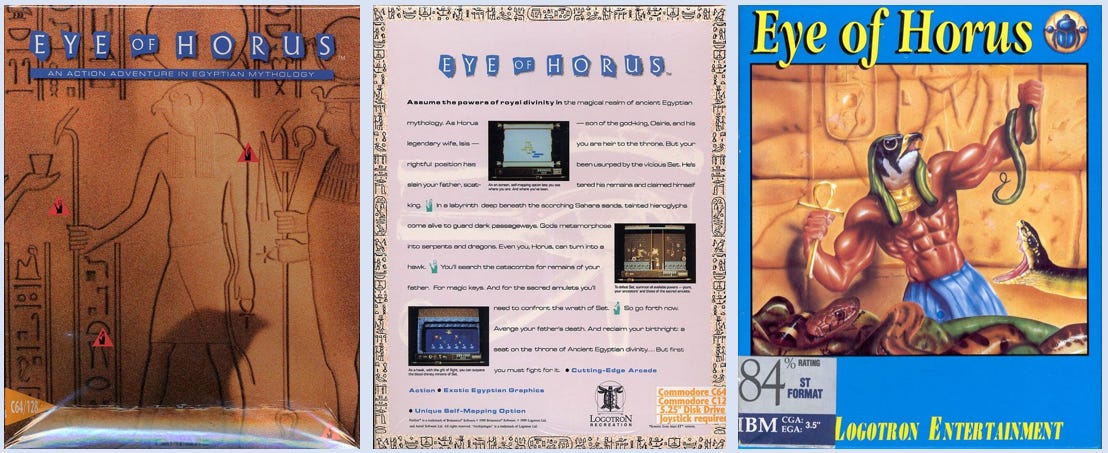The Classic PC Gaming Era (1977-1989) - Eye of Horus
A great-looking Egyptian-themed action platformer in the style of Metroid.
RELEASE DATE: 1989
DEVELOPER / PUBLISHER: Denton Designs / Fanfare
PLAYABILITY TODAY: Fairly playable
BEST VERSIONS: Amiga, Atari ST

What do you get when you combine a shoot ‘em up like R-Type with the side-scrolling exploration of games like Metroid or Zelda II: Link’s Awakening? If it’s 1989, you get Denton Designs’s Eye of Horus, a gorgeous action-adventure game that’s set in ancient Egypt and which uses hieroglyphic art styles for its characters and environments. And while the game does feel a little bit dated to modern sensibilities, it also feels like a title that was far ahead of its time in the late 1980s, particularly in its surprisingly smooth MS-DOS version. (Unusually for the era, the Commodore 64 version is actually the least impressive of the bunch.)
The premise of Eye of Horus is that you are the titular hawk-headed deity and you’ve been tasked with retrieving seven pieces of your father-god, Osiris, so you can gain enough power to vanquish the winged serpent-god Set. Much like Metroid, this means you’ll spend a lot of time exploring an ornate tomb and retrieving magical amulets which can help you to progress by giving you the boost needed to defeat powerful enemies or by giving you skills needed to access certain areas. Many of the enemies come straight out of the hieroglyphs on the wall and can become quite obnoxious if you allow them to multiply, so it’s a good idea to shoot ahead of any direction in which you’re running.

What’s particularly novel about this game is that in addition to your humanoid form, you can transform into a hawk simply by pressing up and then fly around the rooms in free range shoot ‘em up style. Your hawk form can also be upgraded with some of the amulets you find, and honestly, the hawk form is so useful (and makes you such a smaller and more maneuverable target) that you’ll play a good chunk of the game that way.
While Eye of Horus is a challenging game with controls that take some getting used to, it’s not a terribly long adventure, and with minimal guidance, it can be completed in a couple of hours once you get used to the mechanics. Today, it definitely holds up and is a fun retro game to discover if for no other reason than the Egyptian theming is so well-implemented in the design and presentation.
It’s hard to understand why Eye of Horus didn’t do better commercially in 1989, and that’s perhaps a function of being part of a genre that hadn’t really crystalized yet (like Exile, it’s an early example of a progressive exploration game that we’d now call a Metroidvania) and also arriving at a time when arcade action was expected to be more visceral and cutting-edge. The Amiga and Atari ST versions play well and look nice; the music is also quite well-done and aids the spooky atmosphere of wandering around a tomb. I recommend those versions over the others.

While Dragon magazine panned this game - criticizing, of all things, the beautiful Amiga graphics! - Eye of Horus received some decent reviews upon its debut and probably deserved more attention than it received. Unfortunately, it was overshadowed by 1989’s Shadow of the Beast, a monster hit which became the gold standard for PC action platformers.
As Our Series Continues…
In the coming weeks, we’ll talk about arcade action games, 3D games, flight simulators, sports games, gameroom games, puzzle games and so much more.
And while you’ll definitely see some titles from prominent North American publishers like Sierra On-Line, Infocom, Activision, Electronic Arts, Brøderbund, SSI, MicroProse, Lucasfilm Games, Epyx and Sir-Tech in the mix, you’ll also see references to games from the United Kingdom, Australia, France, Spain and Japan.
If you’ve missed the earlier entries in the series, which cover ASCII games, adventure games, wargames, strategy games and role-playing games, you can find the entire archive at https://greatestgames.substack.com.
Anything I don’t share here will be in my upcoming book, tentatively titled The Greatest Games You (Probably) Never Played Vol. 1. Subscribe to this newsletter so you won’t miss it!



